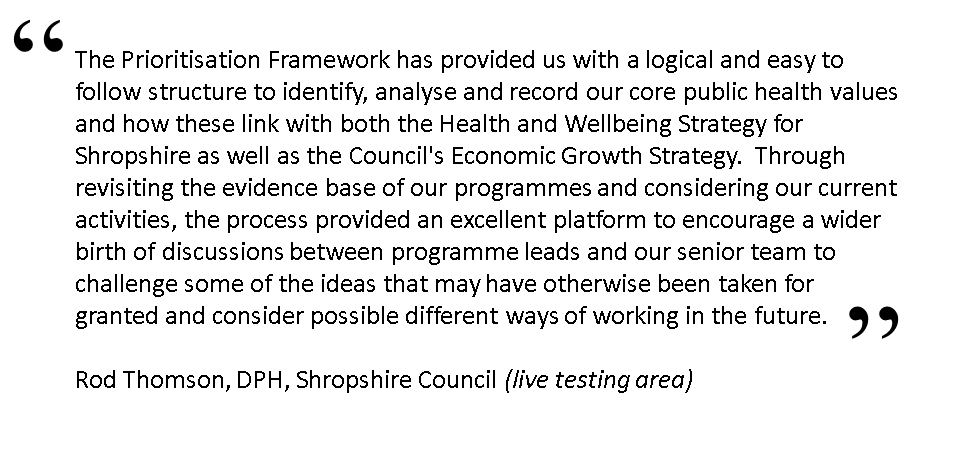We've published a new ‘Prioritisation Framework’, a strategic planning resource for local authorities. In this blog, our Chief Economist Brian Ferguson, and PHE North East Centre Director Peter Kelly, answer questions about how the Framework can inform investment decisions.
What is the ‘Prioritisation Framework’?
The Prioritisation Framework is a planning tool that helps local authorities make evidence-based decisions on how they fund their public health programmes, greatly simplifying the process of undertaking a systematic prioritisation exercise.
It recognises and facilitates the complex investment or disinvestment decisions that every local area has to make.
All local authorities are under budget pressures and operate in different political contexts with different health needs. The Prioritisation Framework can be used to build consensus so when investment decisions are made they are based on a clear set of criteria.
And if local areas need to disinvest or re-allocate funds then this process can provide clarity and transparency on how these decisions were taken.
Local public health teams have unique knowledge about the health profile of their population and the Prioritisation Framework helps determine which programmes are of greatest importance to local people, comparing this with the current investment the programme receives.
The process also brings strategic and operational considerations into play to determine which changes are actually feasible and whether spend in each programme area should be increased, maintained or decreased.
Why is the Prioritisation Framework needed?
We’ve produced a number of ROI tools looking at particular health conditions and these have been well received, but local areas have asked us for support in making decisions across public health programmes.
We also know there’s demand for tools which help answer the question “how did you decide on investment or disinvestment decisions?”
This is an important issue for local areas who want to reduce the need to make funding decisions based on historical spending trends or the need for disinvestment decisions based on ‘salami slicing’; reducing all programme budgets by the same percentage.
How has the Framework been developed?
The idea emerged in 2015 when the Director of Public Health from South Tyneside asked our North East Centre for support to implement reductions in public health spending in a way that was transparent and ensured the best outcome for local people.
In collaboration they developed and tested a prioritisation process based on multi-criteria decision analysis. The process resulted in clear recommendations and was felt to be an evidence-based and acceptable way to manage challenging financial reductions.
Since then we’ve been working with a number of local authorities to co-produce a tool which captures and builds on that approach; the Prioritisation Framework.
This included initial conversations about the functionality of the framework, in-depth interviews after a prototype was developed and finally live-testing in four areas.
How does this process work in practical terms?
We’ve produced a range of guidance and worked examples to assist teams who use the tool, but in brief, we believe each area will need to put together a small team with a “process owner” responsible for leading the process and completing the prioritisation framework.
A commitment of around five months is needed, although we estimate that on average it requires around 10 days of a person’s work, spread across the team. Over the course of the exercise a local authority would run workshops which focus on:
- Agreeing and weighting key criteria to apply to the prioritisation (such as ROI, local burden of disease, health inequalities)
- Scoring public health programmes against the weighted criteria and producing a ranked list
- Collating and scoring evidence about investment, outcomes and feasibility of change
- Combining scores and producing recommendations.
There is also an option to carry out scenario modelling to model different budget allocations.
Local PHE Centres can provide advice and as more local authorities use the framework our national Health Economics team will assess the types of guidance and support that are most helpful.
This additional PHE centre support for Local Authorities using the Prioritisation Framework will be rolled out in a phased way starting with East Midlands, North East, Yorkshire and Humber and the North West.
It’s important to note that the new Prioritisation Framework doesn’t require in-depth health economics knowledge – it’s very much a strategic tool.
We believe the process is manageable for local authorities and indeed some local authorities have designed their own similar systems.
When is the best time to initiate this process?
From discussions with local authorities we see that whilst there are peaks in commissioning activity at certain times of the year in reality budget decisions are made all year round as service contracts come up for renewal.
We hope by launching the Prioritisation Framework now, interested local authorities can take some time to assess the process, access the additional guidance and then think about the best time to make a start in their area.
What resources are available?
You’ll find the Prioritisation Framework on GOV.UK but please also contact PHE’s Health Economics team to access the additional supporting materials.
Your local PHE Centre can also advise you throughout the process – contact them for more information about the phased roll out of this support.




1 comment
Comment by honesthealth365 posted on
nice article
http://www.honesthealth365.com